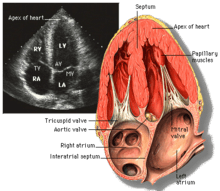Transthoracic echocardiogram
A transthoracic echocardiogram (TTE) is the most common type of echocardiogram, which is a still or moving image of the internal parts of the heart using ultrasound. In this case, the probe (or ultrasonic transducer) is placed on the chest or abdomen of the subject to get various views of the heart. It is used for a non-invasive assessment of the overall health of the heart, including a patient's heart valves and degree of heart muscle contraction (an indicator of the ejection fraction). The images are displayed on a monitor for real-time viewing and are also recorded.
 |  |  |  |  |  short axis | ||||||
| Each figure contains a TTE with a black background, and a corresponding colored illustration. | Patrick J. Lynch and C. Carl Jaffe, Yale University, 2006. | ||||||||||
| Click on a figure to enlarge it and see some parts of the heart identified. RV, right ventricle; LV, left ventricle; RA, right atrium; LA, left atrium; TV, tricuspid valve; MV, mitral valve; AV, aortic valve; RVOT, right ventricular outflow tract; LVOT, left ventricular outflow tract | |||||||||||
An echocardiogram can be used to evaluate all four chambers of the heart. It can determine strength of the heart, the condition of the heart valves, the lining of the heart (the endocardium), and the aorta. It can be used to detect a heart attack, enlargement or hypertrophy of the heart, infiltration of the heart with an abnormal substance. Weakness of the heart, cardiac tumors, and a variety of other findings can be diagnosed with an echocardiogram. With advanced measurements of the movement of the tissue with time (Tissue Doppler), it can measure diastolic function, fluid status,[1] and ventricular dyssynchrony.
TTE in adults is also of limited use for the structures at the back of the heart, such as the left atrial appendage. Transesophageal echocardiography may be more accurate than TTE because it excludes the variables previously mentioned and allows closer visualization of common sites for vegetations and other abnormalities. Transesophageal echocardiography also affords better visualization of prosthetic heart valves and clots within the four chambers of the heart.
"Bubble contrast TTE" involves the injection of agitated saline into a vein, followed by an echocardiographic study. The bubbles are initially detected in the right atrium and right ventricle. If bubbles appear in the left heart, this may indicate a shunt, such as a patent foramen ovale, atrial septal defect, ventricular septal defect or arteriovenous malformations in the lungs.[2]
See also
Footnotes
- ↑ Ommen SR, Nishimura RA, Appleton CP, Miller FA, Oh JK, Redfield MM, Tajik AJ (2000). "Clinical utility of Doppler echocardiography and tissue Doppler imaging in the estimation of left ventricular filling pressures: A comparative simultaneous Doppler-catheterization study" (PDF). Circulation. 102 (15): 1788–94. doi:10.1161/01.cir.102.15.1788. PMID 11023933.
- ↑ Soliman OI, Geleijnse ML, Meijboom FJ, Nemes A, Kamp O, Nihoyannopoulos P, Masani N, Feinstein SB, Ten Cate FJ (June 2007). "The use of contrast echocardiography for the detection of cardiac shunts". European Heart Journal – Cardiovascular Imaging. 8 (3): s2—s12. doi:10.1016/j.euje.2007.03.006. PMID 17462958. Retrieved 2012-08-29.
External links
- Virtual Transthoracic Echocardiography - online learning resource
- Basic ultrasound, echocardiography and Doppler for clinicians